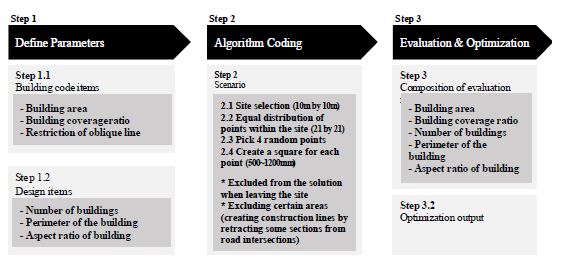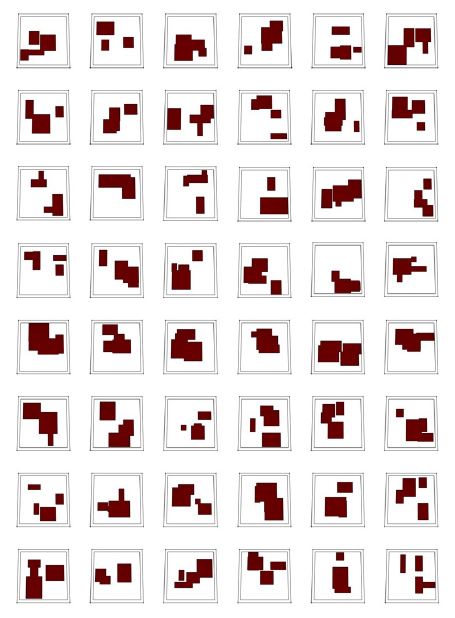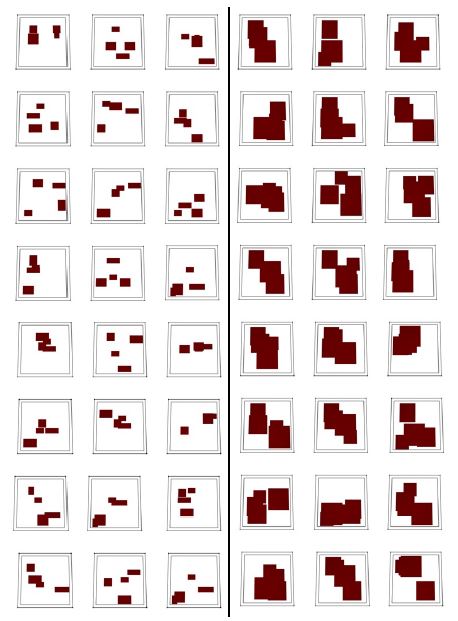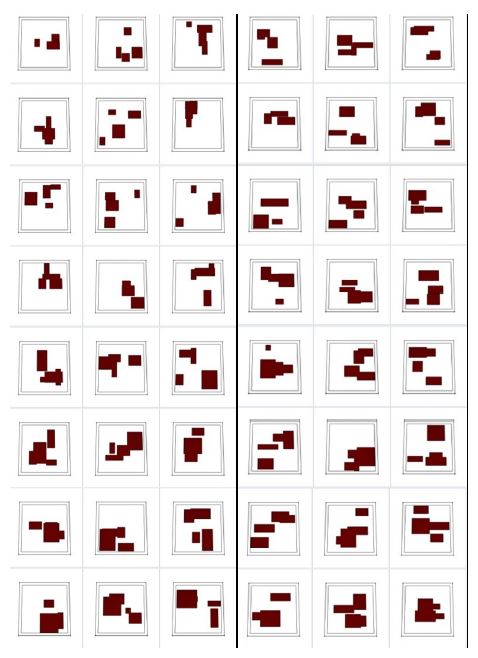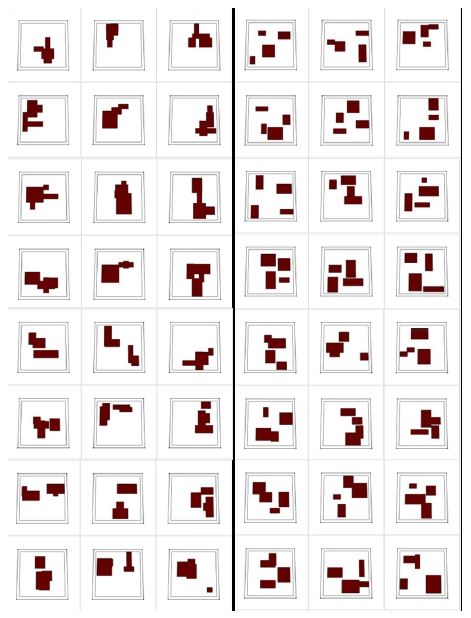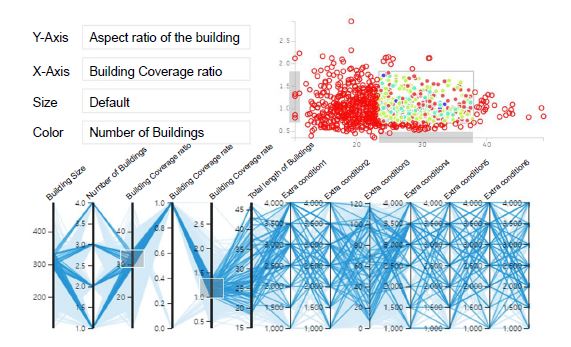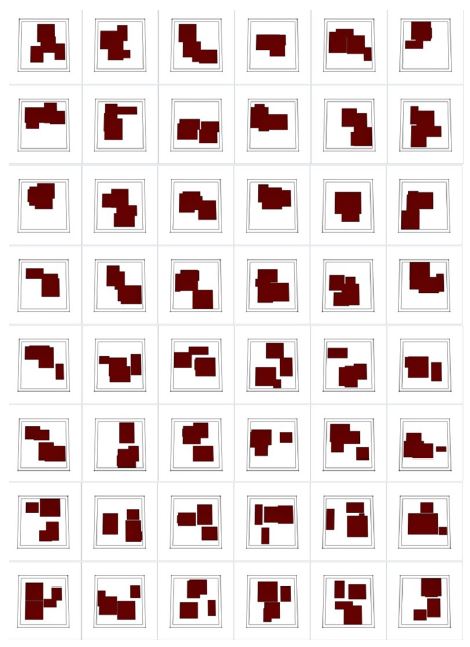
Conceptual Design Algorithm Configuration Using Generative Design Techniques
ⓒ 2023. KIEAE all rights reserved.
Abstract
The aim of this study is to investigate design automation and generative design cases in the field of construction using artificial intelligence (AI) and generate alternatives using generative design techniques in the planning and early design stages of a building. Previous studies indicate that AI-based design automation techniques can be used to design the paradigm of the existing construction and design field, thus improving the construction productivity. In this study, we have conducted additional research to understand the application of generative design in the planning and initial design stages of buildings to provide research directions for Korean design automation and generative design suitable for domestic situations.
We have used Autodesk's Revit and Dynamo programs to generate alternatives using generative design techniques. Dynamo is a visual coding program and is used in conjunction with Revit. First, problems associated with attribute classification and methodology are defined. Then, a grid is formed in an arbitrary site.
Based on the layout design, we have identified three evaluation methodologies, namely building coverage ratio, ratio of the width and length of the building, and number of buildings. In addition, we have created a layout design plan with an optimal alternative. In the future, numerous alternatives can be generated in the conceptual and detailed design stages through additional algorithm modifications and the application of deep learning-based machine learning technologies. Moreover, various evaluation and systemized generative design techniques can also be implemented through the platform.
Keywords:
Generative Design, Conceptual Design, Artificial Intelligence, Algorithm키워드:
제너레이티브 디자인, 컨셉 설계, 인공지능, 알고리즘1. Introduction
1.1. Research Background and Objectives
Artificial intelligence (AI) has emerged as a key driver of the construction industry, and related studies have recently surged in the field of construction research. In particular, various studies on design optimization are underway that are based on AI, data, and optimization theories[1]. They are divided into various sub-areas, such as topology optimization, computer-aided engineering (CAE), simulation, and generative design[2]. However, these studies evolve into research based on generative design, in which AI automatically generates design alternatives unlike humans who take time. In other words, generative design refers to technology in which very many optimal designs are generated based on the purpose of design, constraint types, and their corresponding levels defined by the designer or engineer[3].
The overall process of generative design in the field of construction can be summarized into three stages[1, 4].
Stage 1: Problems associated with types of attributes are defined, and the levels based on the types are set.
Stage 2: Respective topology-optimized designs are generated according to the combination of problem definitions.
Stage 3: The generated designs are reviewed based on the evaluation criteria and representative designs are selected.
In the year 2020, the construction industry faced the biggest crisis due to low construction productivity and increasing age of workers. Accordingly, various solutions were proposed[5]. First, in the technical aspect, efforts for automation of construction are underway based on the Fourth Industrial Revolution and AI. In particular, basic research related to design automation is underway in the design field. Second, in the economic aspect, efforts to improve construction productivity have been made by securing a research base at the national level through the development of construction software in South Korea. Finally, in the social aspect, efforts to improvise repetitive tasks with low value addition to solve the aging and evasion problems of construction workers.
Moreover, AI can be combined with various fields to break the stereotypes of innovation and conventional theories. For instance, AlphaGo, which is an AI program on Go designed by Google DeepMind, competed against humans in 2016 and was the first of its kind to win a Go match against a professional player[6]. This was due to AI that changed the paradigm of Go completely. The AI-based Go program had significant influential power that raised doubts about the conventional Go theories, efforts to destroy them, breaking of stereotypes, and a full-fledged re-examination of human Go games as a whole. Therefore, if AI-based design automation techniques are developed in the construction field, it is expected to revolutionize the existing paradigm of the construction field and dramatically improve construction productivity.
Moreover, the demand for generative design techniques in the field of construction design has increased with the introduction of AI-based Fourth Industrial Revolution technologies. Accordingly, a number of related studies are underway, including those based on the review and analysis process in the design and construction of automation platforms and systems along with the planning and design field and detailed design field[7].
The purpose of this study is to investigate the feasibility of using generative design to improve productivity in the field of construction and reduce repetitive and unnecessary work for the aging construction workforce. To this end, previous studies are analyzed, based on which generative design methodologies are systematically classified. Furthermore, the aim of this study is to use a generative design methodology in the process of designing the building layout to create various layouts and evaluate some of them to show the process of selecting better alternatives. Based on this, we can derive the implications for the development of AI, AI-based design automation, and generative design techniques in the construction sector and provide directions for vitalizing future research.
1.2. Method and Scope of Research
AI-based design automation and generative design techniques are the most important techniques for implementing intelligence, knowledge, and automation at the design stage and play a key role in introducing digital transformation in the fields of construction and maintenance.
In this study, we have analyzed relevant previous studies to understand AI-based design automation and generative design in the construction sector. Furthermore, we have conducted research to understand different ways of using generative design in the building planning and initial design stage to suggest a research direction for South Korea-type design automation and generative design that is suitable for domestic purpose. The directions suggested in this study can be used as basic data for related technical development and research in the future. In addition, they can help to discover related technologies and research topics and set the direction for research.
2. Trend of Overseas Research on Generative Design in the Construction Field
In this study, we have used the Web of Science as a search engine to investigate the overseas research trend, and analyzed and classified 35 studies related to generative design as shown in Table 1. below. Each study is analyzed based on the categories of creative design, detailed design, performance evaluation, and service & platform, and detailed analysis was performed[8].
2.1. Creative Concept Design
Studies on creative design are classified into three categories. The first category is the enhancement of algorithms. Various algorithms are applied to generative design, and studies have been conducted to merge algorithms of different fields or enhance existing algorithms in this process. The second category is the use in a preliminary feasibility study. It is a research field in which various conditions at the construction planning stage are examined and the design is implemented. The last category is the extraction of numerous alternatives. Studies have been conducted to consider design constraints as input and rapidly generate various alternatives at the concept design stage.
Christiane Herr[17] focused on the transition of cellular automata (CA) by limiting the characteristics of CA according to the requirements of construction design and analyzed the application process of CA as a design tool. This process uses generative design techniques using non-deterministic design tools, which include changes in CA rules, changes in cell shapes, consideration of site context, adaptation to a specific design scale, interpretation of results in an abstract approach, and conceptualization of CA.
Abdullah AlOmani[31] developed a novel methodology to automate the generation of thematic architectural layout designs inspired by images of nature. This methodology used image processing to segment nature-inspired images and applied boundary extraction algorithms to generate each region. Furthermore, spatial regions were optimized to maximize the architectural layout function.
Woojae Sung[41] proposed a method of automating the building layout at the site using a grid-based cellular system. The calculations performed in this method are characterized by low cost and time, thus allowing users to expect very fast real-time calculation results. Furthermore, since there is no need to predict the result and make assumptions, the user can obtain automated building layouts instantly. This has the advantage of exploring many design alternatives in a short time.
2.2. Detailed Design
Studies on detailed design are classified into three categories. The first category is detailed design. Adequate research has been conducted on the techniques of (semi-)automating detailed designs based on the basic design using generative design methods. The second category is design automation research for specific parts. Studies have been conducted to use generative design methods for certain parts, such as the façade or layout of buildings. The last category is research on atypical design that can be implemented based on visual programming languages and graphical algorithm editors used in three-dimensional modeling.
Asli Agirbas[28] investigated the three principles (separation, alignment, and cohesion) of swarm intelligence for possible use in automated architectural design and façade design. The script was composed using Grasshopper software, which is a plugin for Rhino. Based on its flow, the script can be divided into a user-defined part (morpho-dynamic part) and an automated part (morphogenetic part). Various inputs can be defined according to the designer’s expertise in the user-defined part, based on which a façade model is generated in the automated part.
2.3. Performance Evaluation
Studies on performance evaluation are classified into three categories The first category is environment-related evaluation, and adequate research has been conducted using generative design techniques to evaluate the structure, building energy, noise, daylighting, and wind corridor. The second category is the review of architecture-related laws. Since various legal criteria, such as daylighting, distance between apartments, floor area ratio, and building coverage ratio can be mathematically formulated, extensive research has been conducted on the method of linking them to design. The last category is design and constructability evaluation. Research has been conducted to judge and evaluate the consistency of data in design and space-time and improve constructability.
Kyung Sun Lee[2] developed an algorithm that automatically generates various shapes of the building façade using genetic algorithm methods and Voronoi and Delaunay surface-partitioning methods. By combining this algorithm with the daylighting performance evaluation method, a methodology to generate various shapes of building façade considering the performance of AI was also proposed.
2.4. Service and Platform
The scope of service and platform-related research includes the standardization of information, deployment of decision-making service, and provision of a building information modeling (BIM)-based integrated platform.
Jiansong Zhang[21] proposed a novel integrated automated compliance checking (ACC) system for semantic natural language processing. Ioannis Chatzikonstantinou[22] proposed a decision support framework to process design preferences. Since this model provides high-performance design solutions that satisfy the preference for physical properties, the design problem can be solved in a desired way by the decision-maker.
2.5. Sub-conclusion
Based on the description in Section 2, we have identified that generative design methods are planned, applied, and used in a variety of fields, such as BIM (Revit, Rhino), visual programming (Dynamo, Grasshopper), and algorithm development in the architectural design process. In the creative conceptual design field, particularly, relevant studies are conducted to create relatively diverse alternatives based on parameters faster based on AI and automation methods.
Therefore, in this study, we have focused on developing an algorithm that generates numerous design results rapidly in the process of designing the layout concept of buildings. The goal is to provide a method in which the algorithm generates various alternatives while evaluating designs, thus combining the generative design algorithm with the performance evaluation methodology.
3. Research on Building Layout Design Algorithm Configuration
In this study, we have used Autodesk’s Revit and Dynamo programs to generate alternatives using the generative design technique in the planning and early design stage of buildings. Dynamo is a visual programming program and is usually used along with Revit. Unlike common programming languages, Dynamo has the characteristic of using visual elements so that users who are not familiar with programming languages and can write algorithms that computers can understand.
In this study, therefore, we have used this program to build a methodology for defining problems in the generative design technique, based on which various layout design alternatives were generated. Finally, we chose a representative design based on the evaluation criteria among numerous design alternatives.
3.1. Defining Attribute Classification and Methodology for Problem Definition
The design layout algorithm for the concept stage was implemented by dividing the task into four steps as shown in Step 2 in Fig. 1. The first step is the site selection. The most commonly used dimension is 10 × 10 m, which is a basic criterion. Second, 441 arbitrary transparent points (21 X 21) are placed in the form of grids in the site as shown in Fig. 2. Third, an algorithm was created to select four points randomly from the 441 arbitrary points. Finally, a square of 500–3,000 mm is created at each of the four points, and they are combined to create a layout alternative.
Furthermore, with respect to the designation of building lines in Article 46 of the Building Act, we have added an algorithm to connect two points retracted by a certain distance from the intersection point of the road boundary line, which is the border of the corner of the site. This is to apply the most basic part of the legal conditions, and the possibility of various conditions that will be added in the future were examined.
3.2. Generation of Layout Design Alternatives
Fig. 3. shows the output of random result values for concept design alternatives based on the design automation algorithm. The number of results can be hundreds to thousands, as configured in the algorithm. Some result values, among countless alternatives, show design characteristics similar to those generated when actual designers and architects perform conceptual designs on a typical site.
Additionally, an algorithm was added to calculate the building coverage ratio. Based on this, alternatives with low and high building coverage ratios are arranged as shown in Fig. 4. The building coverage ratio refers to the area occupied by the land relative to the site area. By adding this value to the algorithm, a difference in design according to the building density can be identified. In other words, it can be seen that the alternatives with low building coverage ratios have relatively monotonous shapes. In contrast, the alternatives with high building coverage ratios have diverse shapes, such as “ㄱ,” “ㄴ,” and “ㄷ”.
Next, an algorithm was added to find the horizontal and vertical lengths of the buildings, and then the sum in each direction was computed to represent them as a ratio. This is used as a criterion for distinguishing buildings that are long in the north-south direction as opposed to building that are long in the east-west direction. Fig. 5. shows the results with high and low aspect ratios according to the algorithm. It can be seen that the long buildings in the east-west direction have more area facing the south, which has the most solar radiation, and those in the north-south direction are favorable for the formation of wind corridor.
Finally, the design results of the buildings were extracted according to the difference in the number of masses as shown in Fig. 6. below. A rectangle corresponding to each point was set as a single mass. When the areas were shared with each other, the number of masses were recognized as one. In this study, an alternative with many masses is represented in the form of four buildings without overlapping rectangles. As a result, the number of masses increases, and the direction of buildings is relatively insignificant in terms of environmental performance, and relatively diverse shapes are produced in the results.
3.3. Selecting Evaluation Criteria and Representative Designs
The generative design method can generate countless alternatives randomly, but it can also produce alternatives with optimized results of the desired items based on various evaluation criteria and control conditions. The six items shown in Fig. 7 below can be used as evaluation criteria: building area, building coverage ratio, the number of buildings, aspect ratio, and total perimeter length. Based on these criteria, alternatives with a low building coverage ratio (high utilization rate of the surrounding land), a relatively high aspect ratio, and large number of masses (diversity) were extracted as shown in Fig. 8.
4. Conclusion
In this study, we reviewed previous studies by classifying generative design techniques that are used and studied in a variety of ways, and then implemented a basic generative design technique that can be used in the conceptual design stage to generate various alternatives. The results presented in this study are summarized as follows.
(1) Previous studies on generative design can be classified into four categories: creative concept design, detailed design, performance evaluation, and service and platform.
(2) According to previous studies, AI-based design automation methods can revolutionize the paradigm of the existing construction and design fields and dramatically improve construction productivity. In particular, when 35 items from a previous study were compared, it was found that generative design techniques were the most advanced in the field of creative conceptual design.
(3) The implementation of generative design technique in the conceptual design stage was conducted based on three steps: (1) defining attribute classification and methodology for problem definition, (2) generation of layout design alternatives, and (3) selecting evaluation criteria and representative designs.
(4) In terms of methodology, we used a method of dividing the zone with grids and generating and combining arbitrary rectangles in the zone. Numerous alternatives were generated through the basic methodology, and three criteria (building coverage ratio, building aspect ratio, and number of masses) were chosen to evaluate the results.
(5) The minimum and maximum values were selected in detail for the three criteria, based on which layout designs with optimal alternatives were generated.
Using previous studies and generative design techniques, we constructed a relatively simple methodology and generated numerous design alternatives. Then, we extracted optimal alternatives from many alternatives based on the evaluation methodology.
In the future, numerous alternatives can be generated at the concept and detailed design stage by modifying the algorithms and applying deep learning-based machine learning methods. Furthermore, generative design techniques can be applied and used systematically through platforms using various evaluation methods.
The purpose of this study was to examine the applicability of the basic concept of generative design in the building layout process. The algorithm based on the procedure was implemented using a visual programming method. As a result, we have confirmed that the algorithm can perform various designs that can be created in the actual layout design process. Furthermore, by applying the evaluation methodology, we confirmed the feasibility of separately extracting alternatives according to the criteria of building coverage ratio, aspect ratio, and the number of masses. However, the limitation of this study is that relatively simple algorithms were used. For the ease of applying algorithms, we selected a simplified site of 10 × 10 m and considered rectangles of 500–6,000 mm, which were as small as architectural spaces. Some elements that are essential in the actual layout design process, such as the building function, path planning, and layout of functions inside the site, as well as external criteria of the site, were not considered. However, they can be included in follow-up studies. It is also necessary to analyze various laws, regulations, and design criteria, which should be considered in the construction process, and add them to the generative design algorithm. Furthermore, additional research is required to add functionalities to consider and set the relationships between various relational variables. One of the problems of this study is that it is configured to draw only parallel lines when creating rectangles on the site. Thus, shapes of diagonal lines cannot be produced for the site. It is expected that more optimized alternatives can be generated according to the designer’s intention by diversifying and refining the items of the evaluation criteria.
Acknowledgments
This study was supported by the Research Operation Cost Support (Main Project) Program of the Korea Institute of Civil Engineering and Building Technology, Ministry of Science and ICT (Project Number 20230117-001, Smart Construction Technology Research for Driving Future Construction Industry and Creating New Market).
References
-
강남우, 제너레이티브 디자인과 인공지능 기반 설계 자동화, 한국 :기계저널, 제59권 제8호, 2019.8, pp.24-28.
N.W. Gang, Generative design and AI-based design automation, Korea: Journal of the KSME 59(8), 2019.8, pp.24-28. -
K.S. Lee, K.J. Han, J.W. Lee, Feasibility study on parametric optimization of daylighting in building shading design, Sustainability, 8(12), 2016.11.
[https://doi.org/10.3390/su8121220]

-
추승연, 지능형 공간계획 및 계획설계 제안 기술, 한국 : 대한건축학회, 제65권 제9호, 2021.08, pp.33-36.
S.Y Choo, Intelligent space planning and planning design proposal technology, Korea : The Architectural Institute of Korea, Vol. 65, No. 9, 2021.08, pp.33-36. -
김근재 외 3인, 건축 기획업무 효율성 향상을 위한 공간 인접성 그래프 추출 알고리즘 개발, 한국 : 대한건축학회논문집, 제38권 제1호, 2022, pp.67-74.
G.J. Kim et al., Development of spatial adjacency graph extraction algorithm for improvingpre-design efficiency in architectural design process, Korea : The Architectural Institute of Korea, Vol.38 No.1, 2022, pp.67-74. -
국토교통부, 스마트 건설 활성화 방안 S-Construction 2030, 2022.
Ministry of Land, Smart construction revitalization plan S-Construction 2030, 2022. -
Silver D. et al., Mastering the game of Go with deep neural networks and tree search, nature, 529(7587), 2016, pp.484-489.
[https://doi.org/10.1038/nature16961]

-
Castro Pena, M. Luz et al., Artificial intelligence applied to conceptual design. a review of its use in architecture, Automation in construction, 124, 2021, p.103550.
[https://doi.org/10.1016/j.autcon.2021.103550]

-
경북대학교 산학협력단, 인공지능 기반 건축설계 자동화 기술개발, 국토교통부, 2020, pp.153-154.
KyungPook National University, AI-based architectural design automation technology development, Ministry of Land, 2020, pp.153-154. -
J.T. Jin, J.W. Jeong, Optimization of a free-form building shape to minimize external thermal load using genetic algorithm, Energy and buildings, 85, 2014, pp.473-482.
[https://doi.org/10.1016/j.enbuild.2014.09.080]

-
Dincer A.E., Cagdas G., Tong H., A computational model for mass housing design as a decision-support tool, Procedia environmental sciences, 22, 2014, pp.270–279.
[https://doi.org/10.1016/j.proenv.2014.11.026]

-
Khalili Araghi, S., Stouffs R., Exploring cellular automata for high density residential building form generation, Automation in construction, 49(A), 2015, pp.152-162.
[https://doi.org/10.1016/j.autcon.2014.10.007]

-
Manrique J.D. et al., Automated generation of shop drawings in residential construction, Automation in construction, 55, 2015, pp.15-24.
[https://doi.org/10.1016/j.autcon.2015.03.004]

-
Hua Hao, Irregular architectural layout synthesis with graphical inputs, Automation in construction, 72(3), 2016, pp.388-396.
[https://doi.org/10.1016/j.autcon.2016.09.009]

-
Zhang L., Wang Y., Shape optimization of free-form buildings based on solar radiation gain and space efficiency using a multi-objective genetic algorithm in the severe cold zones of China, Elsevier Science B.V., Amsterdam, 132, 2016, pp.38-50.
[https://doi.org/10.1016/j.solener.2016.02.053]

-
Dino I.G., An evolutionary approach for 3D architectural space layout design exploration, Automation in construction, 69, 2016, pp.131-150.
[https://doi.org/10.1016/j.autcon.2016.05.020]

-
Song H., Ghaboussi J., T.H. Kwon, Architectural design of apartment buildings using the Implicit Redundant Representation Genetic Algorithm, Automation in construction, 72(2), 2016, pp.166-173.
[https://doi.org/10.1016/j.autcon.2016.09.001]

-
Herr C.M., Ford R.C., Cellular automata in architectural design: From generic systems to specific design tools, Automation in construction, 72(1), 2016, pp.39-45.
[https://doi.org/10.1016/j.autcon.2016.07.005]

-
Gerber David J., Pantazis Evangelos, Wang Alan, A multi-agent approach for performance based architecture: Design exploring geometry, user, and environmental agencies in façades, Automation in construction, 76, 2017, pp.45-58.
[https://doi.org/10.1016/j.autcon.2017.01.001]

-
Guo Z., Li, B., Evolutionary approach for spatial architecture layout design enhanced by an agent-based topology finding system, Frontiers of architectural research, 6(1), 2017, pp.53-62.
[https://doi.org/10.1016/j.foar.2016.11.003]

-
Sharafi Pezhman et al., Automated spatial design of multi-story modular buildings using a unified matrix method, Automation in construction, 82, 2017, pp.31-42.
[https://doi.org/10.1016/j.autcon.2017.06.025]

-
Zhang Jiansong., El-Gohary, Nora M., Integrating semantic NLP and logic reasoning into a unified system for fully-automated code checking, Automation in construction, 73, 2017, pp.45-57.
[https://doi.org/10.1016/j.autcon.2016.08.027]

-
Chatzikonstantinou, Ioannis., Sariyildiz, I. Sevil., Addressing design preferences via auto-associative connectionist models: Application in sustainable architectural Façade design, Automation in construction, 83, 2017, pp.108-120.
[https://doi.org/10.1016/j.autcon.2017.08.007]

-
Liu Hexu et al., BIM-based automated design and planning for boarding of light-frame residential buildings, Automation in construction, 89, 2018, pp.235-249.
[https://doi.org/10.1016/j.autcon.2018.02.001]

-
As Imdat, Pal Siddharth, Basu Prithwish, Artificial intelligence in architecture: Generating conceptual design via deep learning, International Journal of Architectural Computing, 16(4), 2018, pp.306-327.
[https://doi.org/10.1177/1478077118800982]

-
Tafraout S. et al., Automatic structural design of RC wall-slab buildings using a genetic algorithm with application in BIM environment, Automation in construction, 106, 2019, p.102901.
[https://doi.org/10.1016/j.autcon.2019.102901]

-
Karan Ebrahim, Asadi Somayeh, Intelligent designer: A computational approach to automating design of windows in buildings, Automation in construction, 102, 2019, pp.160-169.
[https://doi.org/10.1016/j.autcon.2019.02.019]

-
Fang Yuan, S. Cho, Design optimization of building geometry and fenestration for daylighting and energy performance, Solar energy, 191, 2019, pp.7-18.
[https://doi.org/10.1016/j.solener.2019.08.039]

-
Agirbas Asli, Facade form-finding with swarm intelligence, Automation in construction, 99, 2019, pp.140-151.
[https://doi.org/10.1016/j.autcon.2018.12.003]

-
Cubukcuoglu Cemre et al., OPTIMUS: Self-adaptive differential evolution with ensemble of mutation strategies for grasshopper algorithmic modeling, Algorithms, 12(7), 2019, p.141.
[https://doi.org/10.3390/a12070141]

-
Baghdadi Abtin, Heristchian Mahmoud, Kloft Harald, Design of prefabricated wall-floor building systems using meta-heuristic optimization algorithms, Automation in construction, 114, 2020, p.103156.
[https://doi.org/10.1016/j.autcon.2020.103156]

-
Alomani Abdullah, El-Rayes Khaled, Automated generation of optimal thematic architectural layouts using image processing, Automation in construction, 117, 2020, p.103255.
[https://doi.org/10.1016/j.autcon.2020.103255]

-
Ligler, Heather, Reconfiguring atrium hotels: Generating hybrid designs with visual computations in Shape Machine, Automation in construction, 132, 2021, p.103923.
[https://doi.org/10.1016/j.autcon.2021.103923]

-
Xu Chengran et al., Optimal brick layout of masonry walls based on intelligent evolutionary algorithm and building information modeling, Automation in construction, 129, 2021, p.103824.
[https://doi.org/10.1016/j.autcon.2021.103824]

-
Zhang et al., Generative design and performance optimization of residential buildings based on parametric algorithm, Energy and buildings, 244, 2021, p.111033.
[https://doi.org/10.1016/j.enbuild.2021.111033]

-
Liu Jiepeng et al., Automatic and optimal rebar layout in reinforced concrete structure by decomposed optimization algorithms, Automation in construction, 126, 2021, p.103655.
[https://doi.org/10.1016/j.autcon.2021.103655]

-
Guo Dongming, Onstein Erling, Rosa Angela Daniela La, A semantic approach for automated rule compliance checking in construction industry, IEEE access : practical research, open solutions, 9, 2012, pp.129648-129660.
[https://doi.org/10.1109/ACCESS.2021.3108226]

-
Soliman-Junior Joao et al., Automated compliance checking in healthcare building design, Automation in construction, 129, 2021, p.103822.
[https://doi.org/10.1016/j.autcon.2021.103822]

-
Ghannad Pedram, Y.C. Lee, Automated modular housing design using a module configuration algorithm and a coupled generative adversarial network (CoGAN), Automation in construction, 139, 2022, p.104234.
[https://doi.org/10.1016/j.autcon.2022.104234]

-
Zhou et al., Automated structural design of shear wall structures based on modified genetic algorithm and prior knowledge, Automation in construction, 139, 2022, p.104318.
[https://doi.org/10.1016/j.autcon.2022.104318]

-
Xu Chengran et al., Automated steel reinforcement detailing in reinforced concrete frames using evolutionary optimization and artificial potential field, Automation in construction, 138, 2022, p.104224.
[https://doi.org/10.1016/j.autcon.2022.104224]

-
W.J. Sung, Y.H. Jeong, Site planning automation of apartment complex through grid-based calculation in grasshopper, Automation in construction, 138, 2022, p.104216.
[https://doi.org/10.1016/j.autcon.2022.104216]

-
Otero Roi et al., Semi-automatic roof modelling from indoor laser-acquired data, Automation in construction, 136, 2022, p.104130.
[https://doi.org/10.1016/j.autcon.2022.104130]

-
Zaraza Julian et al., Generative design to reduce embodied GHG emissions of high-rise buildings, Automation in construction, 139, 2022, p.104274.
[https://doi.org/10.1016/j.autcon.2022.104274]


